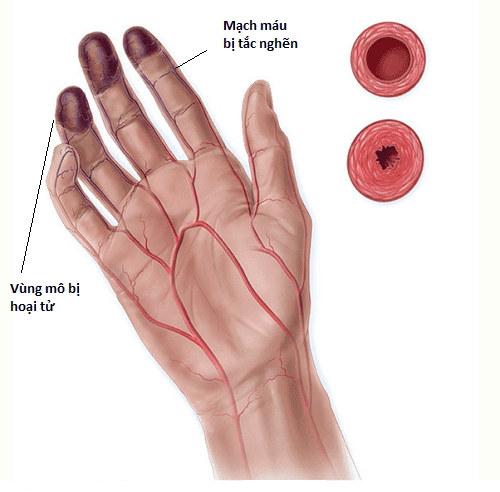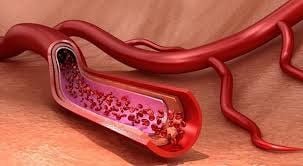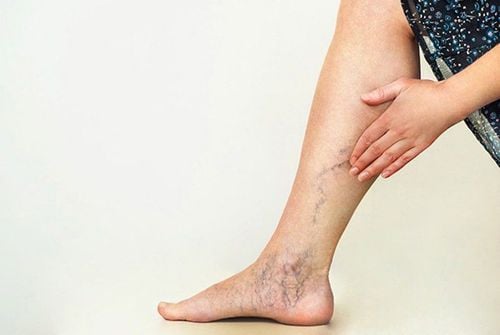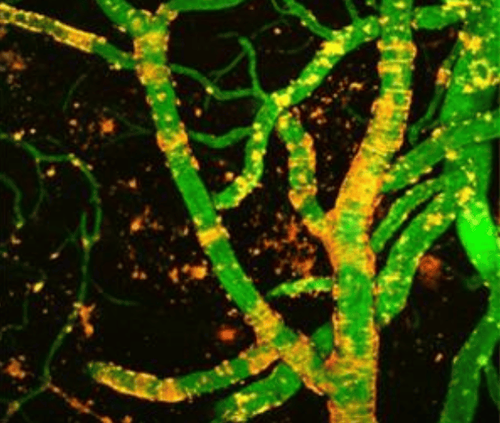This is an automatically translated article.
The article was professionally consulted with Master, Doctor Bui Tien Dat - Emergency Department - Vinmec Hai Phong International General Hospital.Buerger's disease, also known as thromboembolic disease, is a common condition in the small and medium blood vessels in the hands and feet. Buerger's disease is characterized by a combination of inflammation and blood clots in the lumen of blood vessels that impair blood flow to the extremities, leading to tissue damage and destruction, and ultimately infection and necrosis.
1. Diagnosis of Buerger's disease
Your doctor will ask about your symptoms and signs, examine your limbs, and order some tests to help diagnose and differentiate Buerger's disease from other conditions. These tests may include:Blood tests : May help rule out scleroderma, lupus, blood clotting disorders, diabetes... Allen's sign : The patient clenched his fist. The doctor used his hand to squeeze the patient's wrist. Then, the patient opens his palm and the doctor also lets go of his hand from the patient's wrist. Based on the color recovery time in the patient's hand, it is possible to preliminary assess the flow of blood vessels. Slow blood flow to the hands is suggestive of Buerger's disease. Vascular Doppler ultrasound to have the initial assessment of the patient's vascular status. Angiography: also called angiography, helps doctors understand the condition of the arteries. The doctor injects contrast material into the artery and then takes an X-ray or uses other imaging techniques such as multi-slice computed tomography (MSCT), digital background deletion angiography (DSA). The blockages in the artery lumen will be detected immediately.
2. Treatment of Buerger's disease

Stop smoking The simplest and most important thing when being diagnosed with Buerger's disease is to stop smoking. Even smoking one cigarette a day can keep Buerger's disease active, progress, and worsen symptoms.
Smoking cessation is the only treatment known to be effective. Buerger's disease can become "quiet" when you quit smoking. There is also some evidence from studies suggesting that patients should avoid secondhand smoke (passive smoking).
Medicines With Buerger's patient, any skin infection of the hands and feet should be treated promptly with antibiotics. Skin infections can occur as a result of a skin ulcer or after a minor injury.
Pain relievers including non-steroidal anti-inflammatory drugs (NSAIDs), or sometimes stronger drugs such as codeine can be used as needed.
Surgery Surgery to replace blocked arteries is often difficult to perform. However, new techniques for opening individual arteries in the fingers or toes show promise.
If the patient continues to smoke, the blockage of blood vessels will become more severe. Ulcers and gangrene will form and progress, requiring surgery to amputate the finger or toe. Some people need a higher amputation (eg, the entire foot, or the lower leg).
Surgery may also be indicated for pain control in some patients. Cutting the nerves that supply the affected areas (surgical sympathectomy) can help control pain. The technique hasn't been very successful yet, so another method - cutting the nerves around the arteries that feed the fingers or toes - has been developed.
Treatments in Trial Some of the treatments for Buerger's disease have been used in research and clinical trials and are not widely available. These include treatment with a drug called Iloprost given through an intravenous line.
This drug dilates blood vessels and thus improves blood flow. It is also thought to limit the formation of blood clots. In some people with Buerger's disease who have recently quit smoking and who have severe anemia to the hands and/or legs, Iloprost has been shown to:
Improve symptoms. Slows the progression of the disease. Reduces the risk of needing amputation. Several other studies are looking at the use of clot-busting drugs and gene therapy.
3. Measures to help yourself

Dress warmly and avoid cold places as low temperatures can make symptoms worse. Wear well-fitting footwear to help prevent injury. Do not go barefoot. Gentle exercise can help improve blood circulation in the hands and feet. Gentle and warm massage can also help increase blood circulation in the body. Avoid sitting or standing in one position for long periods of time. Avoid wearing tight clothing. The simplest and most important treatment of Buerger's disease is to stop smoking. Even smoking one cigarette a day makes the disease worse. The inflammatory response stops when smoking is stopped. Most patients who quit smoking in time will avoid the risk of amputation later in life.
Please dial HOTLINE for more information or register for an appointment HERE. Download MyVinmec app to make appointments faster and to manage your bookings easily.














